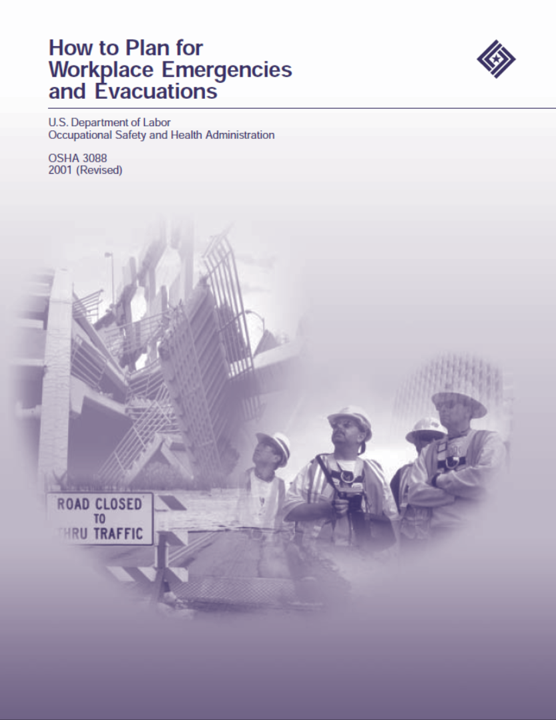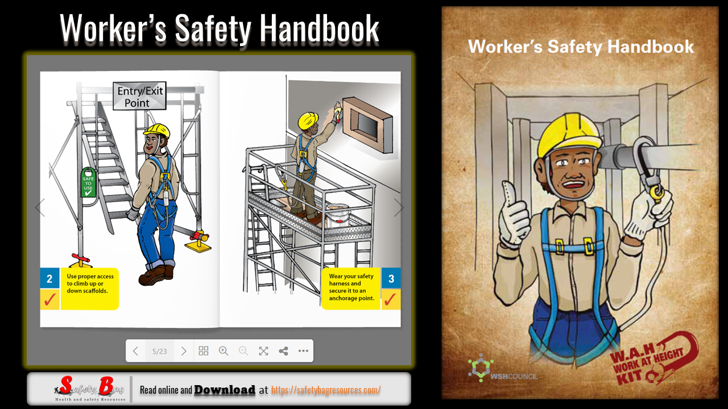How to Plan for Workplace Emergencies and Evacuations U.S. Department of Labor
Occupational Safety and Health Administration

This booklet provides a generic overview of a standards-related topic. This publication does not alter or determine compliance responsibilities, which are described in the OSHA standards and the Occupational Safety and Health Act. Because interpretations and enforcement policies may change over time, the best sources for
additional guidance on OSHA compliance requirements are current administrative interpretations and decisions
by the Occupational Safety and Health Review Commission and the courts.
Nobody expects an emergency or disaster – especially one that affects them, their employees, and their business personally.
Yet the simple truth is that emergencies and disasters can strike anyone, anytime, and anywhere. You and your employees could be forced to evacuate your company when you least expect it.
This booklet is designed to help you, the employer, plan for that possibility. The best way to protect yourself, your workers, and your business is to expect the unexpected and develop a well-thought-out emergency action plan to guide you when immediate action is necessary.
Also Read: Emergency Drill After Action Review form
Read the Book How to Plan for Workplace Emergencies and Evacuation by flipping the File below :
What is a workplace emergency?
A workplace emergency is an unforeseen situation that threatens your employees, customers, or the public; disrupts or shuts down your operations; or causes physical or environmental damage. Emergencies may be natural or unintentional and include the following:
- Floods,
- Hurricanes,
- Tornadoes,
- Fires,
- Toxic gas releases,
- Chemical spills,
- Radiological accidents,
- Explosions,
- Civil disturbances, and
- Workplace violence resulting in bodily harm and
Also Read: Confined spaces brief guide to working safety for Employer and employees
How do you protect yourself, your employees, and your business?
The best way is to prepare to respond to an emergency before it happens. Few people can think clearly and logically in a crisis, so it is important to do so in advance when you have time to be thorough.
Brainstorm the worst-case scenarios. Ask yourself what you would do if the worst happened. What if a fire broke out in your boiler room? Or a hurricane hit your building head-on? Or a train carrying hazardous waste derailed while passing your loading dock? Once you have identified potential emergencies, consider how they would affect you and your workers and how you would respond.
What is an emergency action plan?
An emergency action plan covers designated actions employers and employees must take to ensure employee safety from fire and other emergencies. Not all employers are required to establish an emergency action plan. See the flowchart on page 11 to determine if you are. Even if you are not specifically required to do so, compiling an emergency action plan is a good way to protect yourself, your employees, and your business during an emergency.
Putting together a comprehensive emergency action plan that deals with all types of issues specific to your worksite is not difficult.
You may find it beneficial to include your management team and employees in the process. Explain your goal of protecting lives and property in the event of an emergency, and ask for their help in establishing and implementing your emergency action plan. Their commitment and support are critical to the plan’s success.
Also Read: Books: OSHA-Is it Safe to Enter Confined Space?
The Content of ” How to Plan for Workplace Emergencies and Evacuation “
- Introduction
- What is a workplace emergency? 1
- How do you protect yourself, your employees, and your business?
- What is an emergency action plan? 1
- What should your emergency action plan include?
- How do you alert employees to an emergency?
- How do you develop an evacuation policy and procedures?
- Under what conditions should you call for an evacuation?
- What is the role of coordinators and evacuation wardens during an emergency?
- How do you establish evacuation routes and exits?
- How do you account for employees after an evacuation?
- How should you plan for rescue operations?
- What medical assistance should you provide during an emergency?
- What role should employees play in your emergency action plan?
- What employee information should your plan include?
- What type of training do your employees need?
- How often do you need to train your employees?
- What does your plan need to include about hazardous substances?
- What special equipment should you provide for emergencies?
- How do you choose appropriate respirators and other equipment?
- Who should you coordinate with when drafting your emergency action plan?
- What are OSHA’s requirements for emergencies?
- What other OSHA standards address emergency planning requirements?
- What assistance does OSHA provide?
- What education and training does OSHA offer
- What other publications does OSHA offer?
- What electronic services does OSHA provide?
- What free onsite consultation does OSHA provide?
- What are the Voluntary Protection Programs?
- What partnership opportunities does OSHA provide?
- What is the value of a good safety and health program?
- What is the role of state programs?
- What other groups or associations can help me?
- Appendices:
- OSHA Regional and Area Office Directory
- OSHA-Approved Safety and Health Plans
- OSHA Consultation Offices
( Also Read : Books: CAL/OSHA Pocket Guide for Construction Industry )
Download The Book
How to Plan for Workplace Emergencies and Evacuation
Learn more about Emergency Mangement HERE
More Downloads
- Books: How to Plan for Workplace Emergencies and Evacuation
- Books: Firefighting Precautions at Facilities with Combustible Dust
- Books: A Guide to Electrical Safety
- Books: Preventing Falls in Scaffolding Operations
- Handbook: Worker’s Safety
- Books: A Guide to Safety in Confined Spaces
- Books: OSHA-Hazard communication for small Entity
- Books: OSHA-Permit Required Confined Spaces
- OSHA: Underground Construction (Tunneling)
- OSHA Recommended Practice of Health and Safety programs in construction
- Books: OSHA-Is it Safe to Enter Confined Space?
- Books: General Industry Digest
- Books: A Guide to Bloodborne Pathogens in the workplace
- Books: 5-Minute Workplace Safety Talks
- CAL/OSHA Scaffold Guide for safe use of supported Scaffolds
- Books: CAL/OSHA Pocket Guide for Construction Industry
- Books: Let’s Talk Safety
- Books: OSHA Fall Protection Toolbox Talks and Trainer Guide


